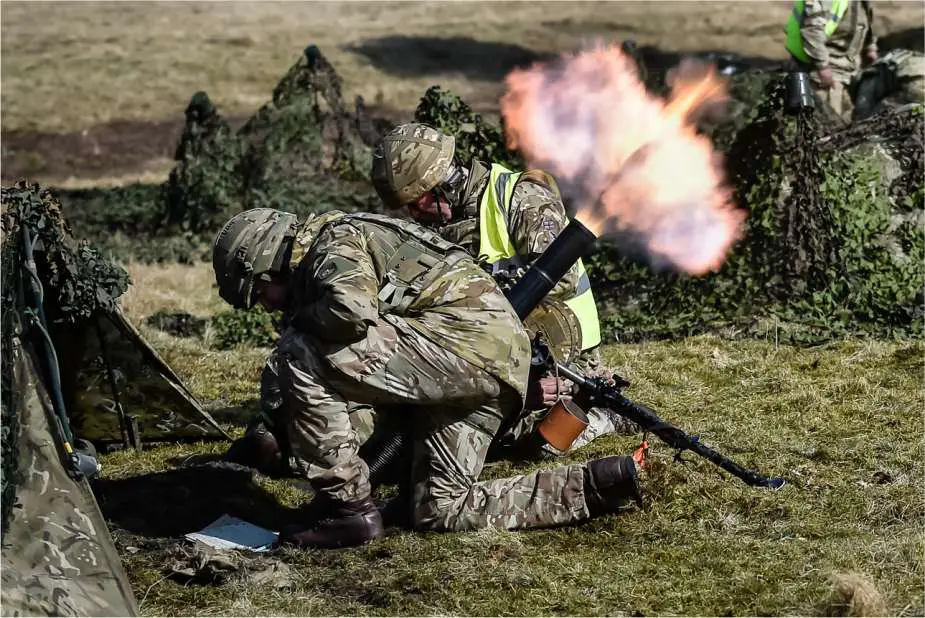United Kingdom opts for 120mm mortars to replace 81mm L16s to cut costs
The British Army is set to enhance its mortar and missile capabilities, focusing on increasing firepower and cost efficiency. British soldiers will soon transition from 81mm mortars to more powerful 120mm mortar systems. This move aims to boost mortar firepower on the ground while wisely managing expenses.
Follow Army Recognition on Google News at this link

British soldier firing a L16 mortar during exercise. (Picture source: UK MoD)
The British Army will replace the 81mm L16 mortars with a new 120mm mortar system, offering superior firepower. The L16 mortars, known for their precision and versatility in delivering explosive, smoke, and illuminating rounds up to 5.6 kilometers, have been a cornerstone of the battlegroup-level indirect fire weapon systems. Deployed from and operated within armored personnel carriers, these systems facilitate quick mobility and rapid repositioning. Although the specific model of the 120mm mortar system the Army plans to deploy remains undisclosed, such systems generally have a range of 7.2 to 9.5 kilometers and are a NATO standard, a distinction not previously adopted by the UK's major Western Army peers.
This initiative further aligns the British Army with NATO allies, enhancing interoperability—an increasingly crucial principle in modern military operations. Notably, the Royal Commandos will continue to use the L16 system due to its ease of deployment, including for airborne operations.
Additionally, the Army is turning to the use of cost-effective 70mm rockets as an alternative to the more expensive Brimstone anti-armor missiles. This change coincides with advancements in Project Wolfram, a British initiative focused on a new mobile anti-armor capability using the Brimstone missile, ready for live fire tests by the second quarter of 2024. Brimstone, versatile across multiple platforms, offers significant capability but comes at a higher cost. In support of Ukraine, the UK has recently sent 200 Brimstone anti-tank missiles.
The L16 mortar is a noteworthy piece of artillery with rich service history and technical specifications that highlight its importance on the battlefield. Originating from the United Kingdom and Canada, the L16 was designed by the Royal Armament Research and Development, focusing on the barrel and bipod components. Its design was finalized in 1956, and production began in 1965 under the oversight of Royal Ordnance for the barrel and bipod.
Weighing in at 35.3 kilograms and boasting a barrel length of 1,280 millimeters, the L16 is an 81-millimeter caliber mortar known for its muzzle-loading action, with a crew typically consisting of three members. This artillery piece doesn't have a breech, relying instead on a baseplate and a spring-buffered mounting clamp to manage recoil. Its shells, which weigh around 4.2 kilograms each, can be fired at a rate of 15 rounds per minute, with a sustained rate of 1 to 12 rounds per minute, and can reach up to 20 rounds per minute for short bursts. The mortar has a muzzle velocity of 225 meters per second and is effective across a range of distances, from 100 meters up to 5,675 meters for high-explosive rounds, and offers similar ranges for smoke rounds. Illumination rounds have a slightly shorter effective range, being usable from 400 to 4,800 meters. Its maximum firing range extends up to 5,650 meters. The L16 operates with a manual feed system and utilizes optical (C2) sights with Trilux illumination for aiming.
Throughout its service history, the L16 has been employed in various conflicts across the globe, showcasing its versatility and reliability. It has seen action in the Nepalese Civil War, conflicts in Borneo, South Arabia, and Oman, the Vietnam War, the Falklands War, the Indo-Pakistani War of 1971, as well as in the Balkans, Kuwait, Iraq, Afghanistan, Mali, and during the Syrian Civil War. Its widespread use across different terrains and conflict scenarios underlines the L16's adaptability and effectiveness in providing indirect fire support.
These adjustments are part of a broader reform aimed at streamlining the UK's defense procurement process, as advocated by the Defence Procurement Minister, James Cartlidge. Highlighting the delivery of systems that achieve 60-80% of their potential upfront, this approach seeks to expedite deployment and facilitate further improvements. It represents a shift from the procurement of bespoke systems to off-the-shelf solutions, reflecting a strategic pivot in modernizing and maintaining military readiness without the high costs of custom development—a challenge also faced by Hungary in its defense procurement strategy.
- Hits: 8458
















